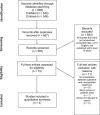CORR Synthesis: What Is the Most Effective Treatment for Rockwood Type III Acromioclavicular Joint Dislocations?
- PMID: 36728233
- PMCID: PMC10097529
- DOI: 10.1097/CORR.0000000000002545
CORR Synthesis: What Is the Most Effective Treatment for Rockwood Type III Acromioclavicular Joint Dislocations?
Conflict of interest statement
Each author certifies that there are no funding or commercial associations (consultancies, stock ownership, equity interest, patent/licensing arrangements, etc.) that might pose a conflict of interest in connection with the submitted article related to the author or any immediate family members. All ICMJE Conflict of Interest Forms for authors and Clinical Orthopaedics and Related Research® editors and board members are on file with the publication and can be viewed on request.
Figures
References
-
- Allman FL., Jr. Fractures and ligamentous injuries of the clavicle and its articulation. Bone Joint Surg Am. 1967;49:774-784. - PubMed
-
- Beitzel K, Cote MP, Apostolakos J, et al. Current concepts in the treatment of acromioclavicular joint dislocations. Arthroscopy. 2013;29:387-397. - PubMed
-
- Beitzel K, Mazzocca AD, Bak K, et al. ISAKOS upper extremity committee consensus statement on the need for diversification of the Rockwood classification for acromioclavicular joint injuries. Arthroscopy. 2014;30:271-278. - PubMed
-
- Boström Windhamre H, von Heideken J, Une-Larsson V, Ekström W, Ekelund A. No difference in clinical outcome at 2-year follow-up in patients with Type III and V acromioclavicular joint dislocation treated with hook plate or physiotherapy: a randomized controlled trial. J Shoulder Elbow Surg. 2022;31:1122-1136. - PubMed
-
- Canadian Orthopaedic Trauma Society. Multicenter randomized clinical trial of nonoperative versus operative treatment of acute acromio-clavicular joint dislocation. J Orthop Trauma. 2015;29:479-487. - PubMed
MeSH terms
Associated data
LinkOut - more resources
Full Text Sources
Medical


